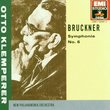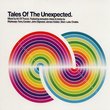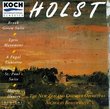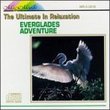| All Artists: Vincenzo Bellini, Orchestra e coro del Teatro alla Scala, Maria Callas, Nicola Zaccaria, Fiorenza Cossotto, Nicola Monti, Giuseppe Morresi, Antonino Votto Title: Bellini: La Sonnambula (complete opera) with Maria Callas, Fiorenza Cossotto, Antonino Votto, Chorus & Orchestra of La Scala, Milan Members Wishing: 0 Total Copies: 1 Label: EMI Classics Release Date: 8/19/1997 Genre: Classical Styles: Opera & Classical Vocal, Historical Periods, Modern, 20th, & 21st Century Number of Discs: 2 SwapaCD Credits: 2 UPC: 724355627827 |
Search - Vincenzo Bellini, Orchestra e coro del Teatro alla Scala, Maria Callas :: Bellini: La Sonnambula (complete opera) with Maria Callas, Fiorenza Cossotto, Antonino Votto, Chorus & Orchestra of La Scala, Milan
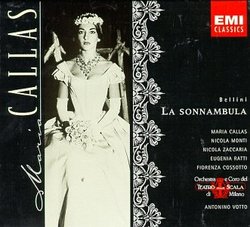 | Vincenzo Bellini, Orchestra e coro del Teatro alla Scala, Maria Callas Bellini: La Sonnambula (complete opera) with Maria Callas, Fiorenza Cossotto, Antonino Votto, Chorus & Orchestra of La Scala, Milan Genre: Classical
You can hear the vocal troubles of Maria Callas's later years just beginning to appear in this 1957 recording. Callas is usually identified with larger-than-life tragic heroines quite different from the simple bride-to-be ... more » ![header=[] body=[This CD is available to be requested as disc only.]](/images/attributes/disc.png?v=15401716) ![header=[] body=[This CD is available to be requested with the disc and back insert.]](/images/attributes/disc_back.png?v=15401716) ![header=[] body=[This CD is available to be requested with the disc and front insert.]](/images/attributes/disc_front.png?v=15401716) ![header=[] body=[This CD is available to be requested with the disc, front and back inserts.]](/images/attributes/disc_front_back.png?v=15401716) |
Larger Image |
CD DetailsSynopsis
Amazon.com You can hear the vocal troubles of Maria Callas's later years just beginning to appear in this 1957 recording. Callas is usually identified with larger-than-life tragic heroines quite different from the simple bride-to-be Amina, whose wedding plans are nearly destroyed by her sleepwalking into compromising situations. But she makes the melodramatic plot emotionally credible, and she rises to the challenges of Bellini's expressively elaborate writing. --Joe McLellan Similar CDs
|
CD ReviewsUnfortunate to read the other reviews daniel vasquez | Atlanta, GA United States | 02/27/2001 (5 out of 5 stars) "there are only two reviews here and none are particularly encouraging. one reviewer cannot believe that callas, one of the formost belcantists of the last century, had "the nerve" to sing this. the other only thinks that callas is the only reason for this set. what is one to say. the idea of what bel canto is has been so shaken from its original roots that you get people thinking that sutherland is bel canto. thats almost like thinking that Native Americans are from INDIA because they are called "indians". (i.e. "bel canto MEANS beautiful singing") silly isnt it? perhaps some research should be done. figure out what kind of singers bellini wrote for, what their range was, what their VOLUME was like. take a look at the orchestration and then think about "is this something that should be sung by a big wagnerian voice like sutherland's?" also think about what kind of soprano callas is. forget about what you have read before. forget the "dramatic coloratura" tag that has been placed on her. read what rossini thought of full toned high notes, should the voice really be even through all the scales and all registers? or is the composer exploiting the sound of each different tone? ('madame pasta's voice is made of a wide variety of metalo'). consider that pasta, malibran, and viardot were NOT sopranos, but pushed up mezzos.....then, after you do all that, tell me what you think of bel canto, and of this recording, which is perhaps one of the greatest testaments of callas' art.daniel" Tuneful, lyrical, gorgeous 09/02/2002 (5 out of 5 stars) "This is one of the opera CDs I pull out most often. If you don't know Callas except in her dramatic roles, you've got a pleasant surprise in store; her voice here is light and unfailingly beautiful. The tenor is easy on the ears too, and their duets are sublime. Great "easy listening" opera." Lovely Sonnambula Pia | 02/20/2005 (5 out of 5 stars) "La Sonnambula, like "Norma", was written for Bellini's muse Giuditta Pasta and hence casting chirpers in this taxing role is completely wrong. The role requires a dramatic soprano d'agilita with an ability to colour her voice in the lightest and airy colours WITHOUT chirping or tweeting. And that was there, right there in Maria Callas' voice. when this was recorded she was singing the role in Köln (Germany) and Edinburgh and had immense successes doing so. Her partner, Mr. Monti, may not be as amazing as Cesare Valletti (On the live-recording from 1955, also available on EMI, the BEST Sonnambula without a doubt) but he's adequate. Votto may not be a Bernstein or Serafin but he conducts with sensivity and Italianita. The "minor" roles are brilliantly cast with the young Fiorenza Cossotto and Nichola Zaccaria. A wonderful, if cut, studio-recording of Bellini's romantic masterpiece."
|

 Track Listings (23) - Disc #1
Track Listings (23) - Disc #1
